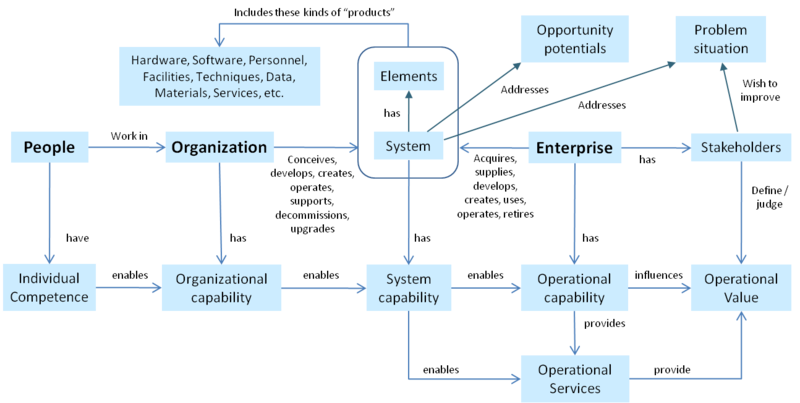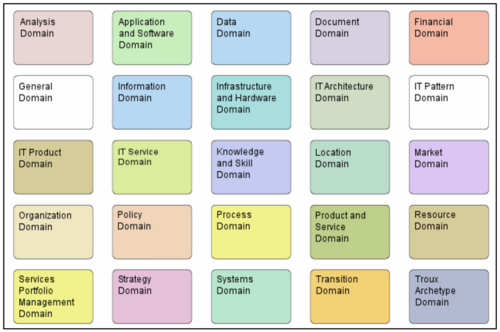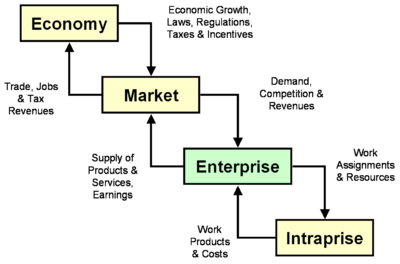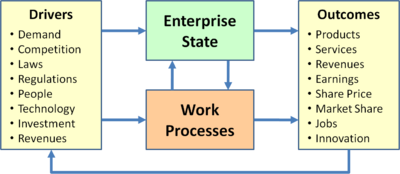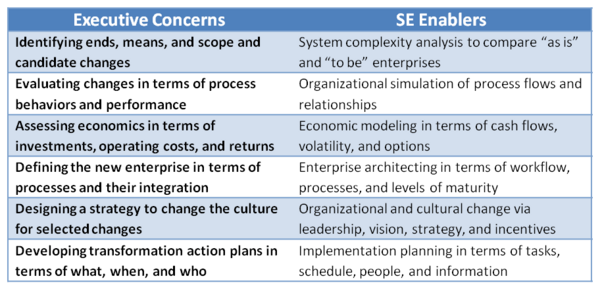Difference between revisions of "Enterprise Systems Engineering Background"
| Line 87: | Line 87: | ||
6.2.4 | 6.2.4 | ||
| − | ==References== | + | ==References== |
| − | + | Please make sure all references are listed alphabetically and are formatted according to the Chicago Manual of Style (15th ed). See the [http://www.bkcase.org/fileadmin/bkcase/files/Wiki_Files__for_linking_/BKCASE_Reference_Guidance.pdf BKCASE Reference Guidance] for additional information. | |
| + | ===Citations=== | ||
| + | List all references cited in the article. Note: SEBoK 0.5 uses Chicago Manual of Style (15th ed). See the [http://www.bkcase.org/fileadmin/bkcase/files/Wiki_Files__for_linking_/BKCASE_Reference_Guidance.pdf BKCASE Reference Guidance] for additional information. | ||
| + | |||
| + | ===Primary References=== | ||
| + | All primary references should be listed in alphabetical order. Remember to identify primary references by creating an internal link using the ‘’’reference title only’’’ ([[title]]). Please do not include version numbers in the links. | ||
| + | |||
| + | ===Additional References=== | ||
| + | All additional references should be listed in alphabetical order. | ||
Revision as of 17:27, 24 June 2011
6.2 ESE Background (3.1.1)
6.2.1
Capabilities and Competencies
The word “capability” is used in SE in the sense of “the ability to do something useful under a particular set of conditions.” This article discusses three different kinds of capability: organizational capability, system capability, and operational capability. It uses the word “competence” to refer to the ability of people relative to the SE task. Individual competence (sometimes called "competency") contributes to, but is not the sole determinant of, organizational capability. This competence is translated to organizational capabilities through the work practices that are adopted by the organizations. New systems (with new or enhanced system capabilities) are developed to enhance enterprise operational capability in response to stakeholder’s concerns about a problem situation. Enterprise stakeholders are the ultimate arbiters of value for the system to be delivered. Organizational, system, and operational capabilities cannot be designed, improved and implemented independently. The key to understanding the dependencies between capabilities is through architecture modeling and analysis as part of the overall Enterprise Capability Management activities described in section 3.1.7. “Capability engineering” is an emerging discipline that could enhance the effectiveness of ESE, which is further discussed in the SOS-KA article.
The relationships among these elements are illustrated in Figure 2, which connects to the previous figure at “people,” “organization,” and “enterprise.” Organizational capabilities are addressed in Chapter 7, and individual competencies are addressed in Chapter 15 as they relate to the principles, theories, and practices of organizational behavior.
Note: Red text in this figure is to indicate changes from the version of this diagram in SEBOK draft v0.25.
Figure 2. Individual Competence Leads to Organizational, System & Operational Capability (Figure Developed for BKCASE)
This article focuses on the operational capabilities of an enterprise and the contribution of these capabilities to stakeholder value. Notice that the organization or enterprise can deal with either the system as a whole or with only one or a few of its elements. These elements are not necessarily hard items, like hardware and software, but can also include “soft” items, like people, processes, principles, policies, practices, organizations, doctrine, theories, beliefs, and so on.
6.2.1
Organizational Design
The competencies of individuals are important to the overall organizational capability as discussed in chapter 15. The organizational capability is also a function of how the people, teams, projects, and businesses are organized. The organizational design should specify the roles, authorities, responsibilities, and accountabilities (RARA) of the organizational units to ensure more efficient and effective operations. Effectiveness of enterprise operations is certainly driven by management principles, concepts, and approaches, but it is also largely driven by its leadership principles, concepts, and approaches. These factors are discussed in chapter 7 on how to organize for effective performance of SE.
Organizational structure is tightly tied to creating value for the enterprise’s various stakeholders. Since the enterprise is made up of various elements including people, processes, technologies, and assets, the organizational structure of the people and the allocation of responsibilities for executing portions of the value stream is a “design decision” for the enterprise and hence is a key element of properly performing ESE. This organizational design will be based on organizational design patterns and their tradeoffs, as discussed in chapter 7.
6.2.2
Enterprise Components
The above depictions of enterprise-related things do not show the components of an enterprise. The components of an enterprise when it is viewed as a “system” are different than the components of a product or service system (which is the focus of most literature on systems engineering). Figure 3 shows the typical kinds of components (shown here as “domains”) in an enterprise (Troux 2010) that may be necessary for achieving the desired enterprise operational capability as shown in Figure 2. It is this operational capability that drives ultimate value for the enterprise’s customers and other stakeholders.
Figure 3. Categories of Enterprise Components (Source: Troux, 2010)
6.2.3
Scope of Enterprise SE
Computer and communications technologies make it easier to integrate activities across the enterprise, but this does not necessarily make the enterprise more effective and efficient. To enable this to happen, one needs to look at the whole enterprise as a system, rather than as a collection of functions connected solely by information systems and shared facilities.
Essential Challenges
Enterprises face strategic challenges (Rouse 2009) that are essential to address in order to ensure that the enterprise will succeed:
- Growth: Increasing impact, perhaps in saturated/declining “markets”
- Value: Enhancing relationships of processes to benefits and costs
- Focus: Pursuing opportunities and avoiding diversions
- Change: Competing creatively while maintaining continuity
- Future: Investing in inherently unpredictable outcomes
- Knowledge: Transforming information to insights to programs
- Time: Carefully allocating the organization’s scarcest resource
To address these challenges, one recognizes that the central source of value in the enterprise is in its people. “Understanding and supporting the interests of an enterprise’s diverse stakeholders—and finding the ‘sweet spot’ among the many competing interests—is a central aspect of discerning the work of the enterprise as a system and creating mechanisms to enhance this work.” (Rouse 2009)
Enterprise Transformation
Enterprises are constantly transforming, whether at the individual level (wherein individuals alter their work practices) or at the enterprise level (large-scale planned strategic changes). (Srinivasan 2010) These changes are a response on the part of the enterprise to evolving opportunities and emerging threats. It is not merely a matter of doing work better, but doing different work, which is often a more important result. Value is created through the execution of business processes. However, not all processes necessarily contribute to overall value. (Rouse 2005, 138-150) It is important to focus on process and how it contributes to the overall value stream.
After gaining a good understanding of business processes, the next main concern is how best to deploy and manage the enterprise’s assets human, financial, and physical. The key challenge in transforming an enterprise is, in the midst of all this change, continuing to satisfice key stakeholders. (“Satisfice” means to decide on and pursue a course of action satisfying the minimum requirements to achieve a goal. For the enterprise as a whole, it is often impossible to completely satisfy all stakeholders given their competing and conflicting concerns and interests. Therefore, the concept of “satisficing” is very important for ESE.)
Transformation Context
Enterprise transformation occurs in the external context of the economy and markets as shown in Figure 4 . (Rouse 2009) The “market” for the enterprise can be thought of as the context in which the enterprise operates. (Of course, in the public sector the enterprise’s “market” is commonly known as its “constituency.”) The term “intraprise” is used here to denote the many systems internal to the enterprise. The intraprise includes more than just the information systems—it also includes the social and cultural systems in the enterprise (see chapter 7).
Figure 4. Context for Enterprise Transformation (Source: Rouse, 2009)
Modeling the Enterprise
Models of the enterprise can serve as the basis for understanding the enterprise in its context of markets and economies. Figure 5 shows the various drivers (or inputs) of an enterprise and its potential outcomes (or outputs). (Rouse 2009) Enterprise architecture can be a key enabler for modeling and can serve as a basis for transformation. (Vernadat 1996; Bernus, Laszlo, and Schmidt 2003; Nightingale and Rhodes 2004) Enterprise architecture can be used to provide a model to understand how the parts of the enterprise fit together (or don’t). (Giachetti 2010)
Figure 5. Drivers and Outcomes for the Enterprise (Source: Rouse, 2009)
6.2.2
In Pursuit of Value
Based on his theory of enterprise transformation, Rouse (2005, 279-295) has identified four alternative perspectives that tend to drive the need for transformation:
- Value Opportunities: The lure of greater success via market and/or technology opportunities prompts transformation initiatives.
- Value Threats: The danger of anticipated failure due to market and/or technology threats prompts transformation initiatives.
- Value Competition: Other players’ transformation initiatives prompt recognition that transformation is necessary to continued success.
- Value Crises: Steadily declining market performance, cash flow problems, etc., prompt recognition that transformation is necessary for the enterprise to survive.
Work processes can be enhanced, streamlined, eliminated, and invented to help in the pursuit of enhanced value. These process changes should be aligned with enterprise strategy to maximize value produced by the enterprise. (Hammer and Champy 1993)
6.2.3
Enabling the Enterprise
ESE, by virtue of its inherent transdisciplinarity (Sage 2000, 158-169) in dealing with problems that are large in scale and scope, can better enable the enterprise to become more effective and efficient. The complex nature of many enterprise problems and situations usually goes beyond the abilities of standard tools and techniques provided to business school graduates. ESE can augment the standard business management methods using the tools and methods from the SE discipline to more robustly analyze and evaluate the enterprise as a holistic system. A more general viewpoint, or “view,” for dealing with the enterprise consisting of scale, granularity, mindset, and timeframe, is provided in (White 2007) and (McCarter and White 2009, 71-105).
ESE can provide the enablers to address the concerns of enterprise executives as shown in Table 1. (Rouse 2009) The methods for dealing with, and the special characteristics of, complex adaptive systems must be properly considered when adapting TSE practices for use at the enterprise level. (von Bertalanffy 1968; Weinberg and Weinberg 1988; Miller and Page 2007; Rouse 2008, 17-25) For an approach to complex adaptive systems engineering (CASE), refer to (White 2008, 1-16) and (McCarter and White 2009, 71-105).
Table 1. Executive Concerns and SE Enablers (Source: (Rouse 2009))
6.2.4
References
Please make sure all references are listed alphabetically and are formatted according to the Chicago Manual of Style (15th ed). See the BKCASE Reference Guidance for additional information.
Citations
List all references cited in the article. Note: SEBoK 0.5 uses Chicago Manual of Style (15th ed). See the BKCASE Reference Guidance for additional information.
Primary References
All primary references should be listed in alphabetical order. Remember to identify primary references by creating an internal link using the ‘’’reference title only’’’ (title). Please do not include version numbers in the links.
Additional References
All additional references should be listed in alphabetical order.
Article Discussion
Dick F. posting:
Should include a link (or links) to Part 4 (Enabling the Organization to Perform Systems Engineering) Part 4.2 (Enabling Individuals to Perform Systems Engineering); 4.3 (Enabling Teams, Projects, and Programs to Perform Systems Engineering); and 4.4 (Enabling Businesses and Enterprises to Perform Systems Engineering)
Not: there may be some disconnects between the way "enterprise" and "organization are used here and in Part 4.
